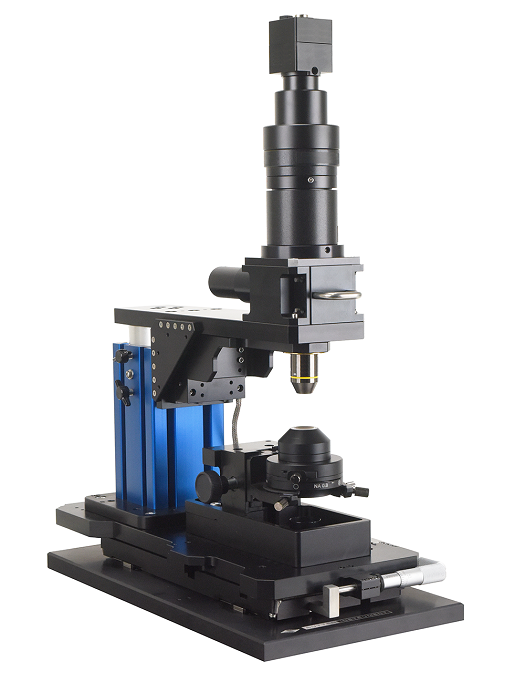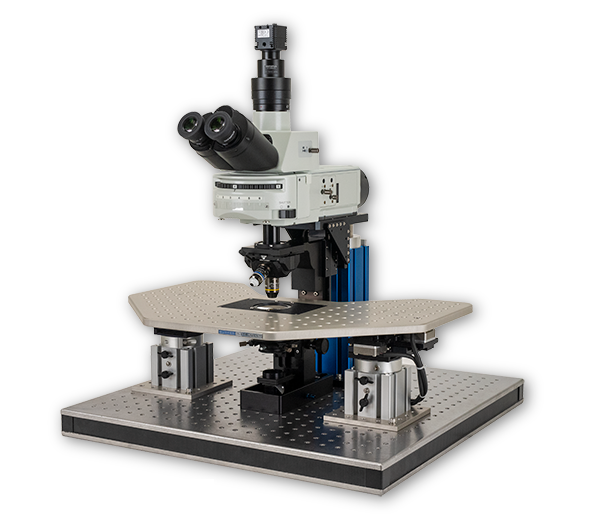Sutter NAN™ is a focusing nosepiece microscope developed for electrophysiology. The microscope frame is based upon Sutter's highly stable and adjustable MT-70 manipulator gantry stands; this means that numerous configurations can be accommodated, to compensate for the ever-expanding list of electrophysiology applications.

NAN-12. Image Credit: Sutter Instrument
The height of NAN can be manually adjusted. With a range of 75mm, this single microscope can be coarsely re-positioned in Z, enabling the user to rapidly switch between in vivo or slice work.
NAN is available in two versions of varying heights, which are determined by the chosen nosepiece.
The gantry stands’ height is 15.25 cm (6”) or 22.86 cm (9”) for the single nosepiece or 2-position swinging nosepiece, respectively. With 25 mm of motorized travel, the focusing nosepiece can be configured with either an Olympus 2-position swinging nosepiece or a single objective nosepiece (Sutter-made).
The epi level can be configured with a single filter cube or a complete Olympus epi-illuminator.
The available transmitted light system offers a choice between an IR LED, a single white light LED, or a dual white light LED configuration.
The illumination through LED transmitted light employs either the Olympus Oblique Coherent Contrast (OCC) condenser or the IR-DIC components, providing a range of contrast methods for users. These LED options are controlled by the TLED controller and can be activated using a digital signal. This design eliminates the need for shutters while also enabling photostimulation from the trans location.
Where transmitted light is not wanted, the LED, condenser focus mechanism, and condensing optics can be easily removed as a single assembly.
The transmitted light path is also much shorter than other systems. This means that the microscope body sits a lot lower down compared to a traditional-style microscope. The shorter a microscope is, the greater its stability, which in turn has a positive impact on ease of use and ergonomics.

NAN-21 with MPC-78 Stage. Image Credit: Sutter Instrument
The NAN can be configured via trinocular eyepieces for visualization. If the user only requires a camera, it can be configured using a C-mount and tube lens.
An important aspect to consider with the NAN is whether to translate the microscope, or move the sample and manipulators together onto a larger platform stage, or translate the microscope but mount the sample and manipulators on a fixed platform stage. All combinations of manual and motorized motion are available for the XY motion.
The three general configurations are as follows:
- Motorized XY platform stage with the microscope fixed to the tabletop
- Manual or motorized translator with manipulators mounted on individual gantry stands
- Manual or motorized translator with manipulators mounted on a large platform stage
The Electrophysiology “rig” can also be fitted with a wide range of accessories, such as Amplifier systems, an epi-fluorescence light source, and manipulators.
An example of the epi-fluorescence source is the FLED-DC which is a two-channel LED system that can be directly mounted to the epi-port of the microscope. If the user requires more than two fluorescent channels, then the Lambda 721 is ideal, as it is a highly configurable LED light source with up to 7 channels. Sutter is also able to provide equipment racks and air tables if required.
Applications
- in vivo, in vitro, and slice
- Patch clamp electrophysiology
- Whole-cell recording
- Material science
- Intracellular recording
Features
- Open-design microscope with motorized focus
- Optional with manual or motorized translator, or motorized XY Stage
- Quickly configurable based on experimental needs
- Optimized to allow in vivo and in vitro experimentation on one setup
- Free Multi-Link™ software coordinates movement with micropipette positioning of MPC-200
- Designed for use with Olympus objective lenses
- Differential Interference Contrast (DIC) or Oblique Coherent Contrast (OCC)
- Epi-fluorescent illumination
Specifications
Technical Specifications
Dimensions
16.5 in × 5.11 in × 13.1 in | 42 cm × 13 cm × 33.3 cm
Weight
NAN-11
39.7 lbs | 18 kg

